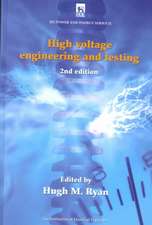Prostheses for the Brain: Introduction to Neuroprosthetics
Autor Andrej Kral, Felix Aplin, Hannes Maieren Limba Engleză Paperback – 9 apr 2021
The book additionally reviews the technology behind the most frequently used and most clinically successful neuroprosthetic devices. It provides the physiological background for their function, as well as the technology behind them. Finally, the authors suggest future possible developments that may play crucial role in new prostheses for the brain. This gives the reader a comprehensive view on the principles and applications of neuroprostheses. This book has been built from the authors course they teach on neuroprostheses and is ideal for students, engineers and medical professionals in this field.
- Introduces the general principles of conductivity of electrolytes and the processes at the tissue–electrode interface
- Describes safety issues and regulatory rules, clarifies conceptual differences between stimulating and sensing electrodes
- Reviews stimulation strategies, tissue reactions, potential medical complications, brain adaptations and the clinically most successful applications of neuroprostheses
Preț: 674.82 lei
Preț vechi: 880.44 lei
-23% Nou
Puncte Express: 1012
Preț estimativ în valută:
129.13€ • 135.16$ • 107.47£
129.13€ • 135.16$ • 107.47£
Carte tipărită la comandă
Livrare economică 24 martie-07 aprilie
Preluare comenzi: 021 569.72.76
Specificații
ISBN-13: 9780128188927
ISBN-10: 0128188928
Pagini: 414
Ilustrații: Approx. 150 illustrations (150 in full color)
Dimensiuni: 191 x 235 x 26 mm
Greutate: 0.71 kg
Editura: ELSEVIER SCIENCE
ISBN-10: 0128188928
Pagini: 414
Ilustrații: Approx. 150 illustrations (150 in full color)
Dimensiuni: 191 x 235 x 26 mm
Greutate: 0.71 kg
Editura: ELSEVIER SCIENCE
Public țintă
Biomedical, Electrical and Mechanical Engineers. Students of biomedical technology. Engineers working with neuroprosthesesCuprins
INTRODUCTION1. Prostheses for the brain: the future of bionics
PRINCIPLES2. Currents and conductivity in electrolytes: ions, polarizing and non-polarizing electrodes3. Excitable tissue: membrane potentials4. Electrical stimulation: Safety and efficacy5. Artificial excitation of axons and neurons: Electrical stimulation rules6. Long-term brain adaptations
APPLICATIONS7. Mechanical prostheses in the auditory system 8. Electrical prostheses in the auditory system (cochlear implants, brainstem and midbrain implants)9. Retinal implants10. Cortical implants11. Deep brain stimulation12. Peripheral nerve stimulation13. Sensing (recording) implants
FUTURE DEVELOPMENTS14. Optogenetics15. Ultrasound stimulation16. Transcranial stimulation
PRINCIPLES2. Currents and conductivity in electrolytes: ions, polarizing and non-polarizing electrodes3. Excitable tissue: membrane potentials4. Electrical stimulation: Safety and efficacy5. Artificial excitation of axons and neurons: Electrical stimulation rules6. Long-term brain adaptations
APPLICATIONS7. Mechanical prostheses in the auditory system 8. Electrical prostheses in the auditory system (cochlear implants, brainstem and midbrain implants)9. Retinal implants10. Cortical implants11. Deep brain stimulation12. Peripheral nerve stimulation13. Sensing (recording) implants
FUTURE DEVELOPMENTS14. Optogenetics15. Ultrasound stimulation16. Transcranial stimulation
Recenzii
"From mt point of view, the book can be used for basic purposes and genetic researchers are clearly recommended. Except for the principle chapter the reader does not need to bring knowledge." --Zeitschrift für Audiologie/Audiological Acoustics



























